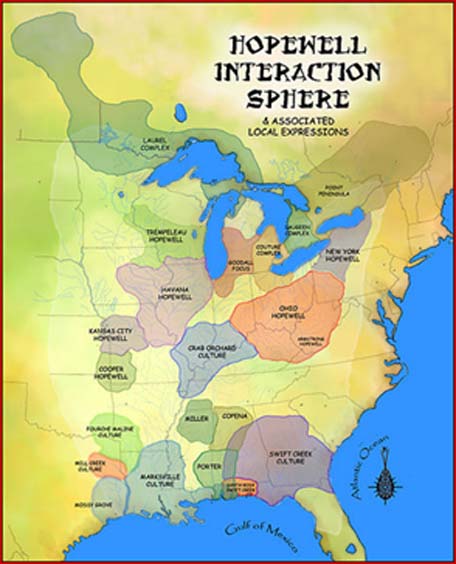The Social Impact of the Bow and Arrow on Prehistoric America
A new technology in weaponry, the introduction of the bow and arrow, might have led to the collapse of the prehistoric, American Hopewellian Culture somewhere between 450 to 500 AD. A socio-spiritual tripartite existed between the Scotio Hopewell cultures and these three communities congregated at times to bury their dead in communal mounds. Such religious ceremonies reinforced the alliances between the living and their ancestors and strengthened their kinship ties. However, something upset this alliance, which had a dramatic effect upon the cultures. Archaeologists noticed a reduction in the sizes of projectile points, which identifies the arrival of the bow and arrow to the scene. This may not seem such a huge event, but it impacted on the interdependence and sharing of food resources during communal gatherings. The bow being much more accurate than the spear, facilitated autonomous hunting by smaller groups, and eliminated the need for large scale hunting drives. Thus, a tripartite alliance could have collapsed, as is evident from a decline in joined burials. The introduction of the bow and arrow, and consequently more autonomous living, triggered an exploitation of wild game, an increase in the cultivation of crops, and a trend towards sedentary and nucleated communities.

The Hopewell Interaction Sphere and various local expressions of the Hopewell cultures by H Rowe (CC BY-SA 3.0)
Timing of the Introduction of the Bow and Arrow
In archaeology, there are some tried and true ideas that stand the test of time, enduring careful scrutiny and the subsequent discovery of additional evidence. On the other side of the coin, there are ideas, which although enshrined and often repeated in a barrage of cognitive reinforcement, should have been cast to the winds long ago, in light of new discoveries and experiments. Since archaeological interpretation is a largely holistic endeavor incorporating multiple streams of knowledge and study, even one problematic concept, which has outlived its own credibility, can serve to blind researchers to the answers they seek or even derail entire fields of inquiry. One such problem in American archaeology is the timing of the introduction of the bow and arrow in the Eastern Woodlands.
Like this Preview and want to read on? You can! JOIN US THERE ( with easy, instant access ) and see what you’re missing!! All Premium articles are available in full, with immediate access.
For the price of a cup of coffee, you get this and all the other great benefits at Ancient Origins Premium. And - each time you support AO Premium, you support independent thought and writing.
Jason Jarrell and Sarah Farmer are investigative historians and avocational archaeologists. They study many subjects including depth psychology, Biblical mysteries, political science, and comparative mythology. They’re also authors of the book, Ages of the Giants: A Cultural History of the Tall Ones in Prehistoric America (2017). | ParadigmCollision.com
Top Image: Buffalo Hunt: A Numerous Group by George Catlin 1844. (Public Domain)




















